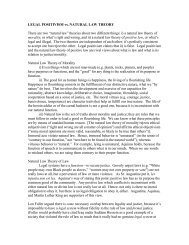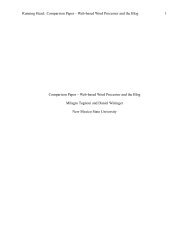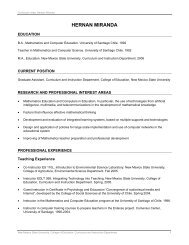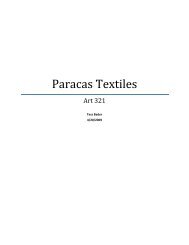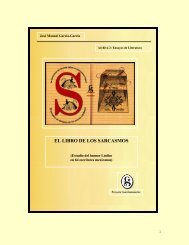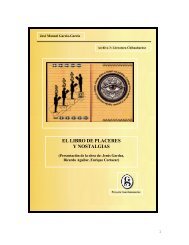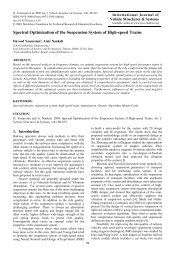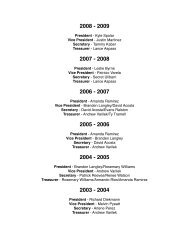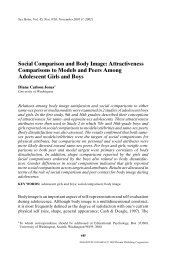The Origins of a Free Press in Prerevolutionary ... - Web Publishing
The Origins of a Free Press in Prerevolutionary ... - Web Publishing
The Origins of a Free Press in Prerevolutionary ... - Web Publishing
You also want an ePaper? Increase the reach of your titles
YUMPU automatically turns print PDFs into web optimized ePapers that Google loves.
82<br />
issues. 63 <strong>The</strong> <strong>in</strong>stitution <strong>of</strong> the c<strong>of</strong>feehouse was grow<strong>in</strong>g <strong>in</strong> popularity both <strong>in</strong><br />
England and <strong>in</strong> the colonies. This type <strong>of</strong> gather<strong>in</strong>g place also served as a forum for<br />
civic discourse. Proprietors <strong>of</strong>ten charged a penny for customers to come <strong>in</strong> to read<br />
the newspapers and use the c<strong>of</strong>feehouse’s tobacco and pipes. 64 Newspapers worked<br />
<strong>in</strong> tandem with such public gather<strong>in</strong>gs to stimulate civic discourse. 65<br />
<strong>The</strong> <strong>in</strong>fluence <strong>of</strong> newspapers was magnified by such multiple transmissions<br />
from reader to listener to other listeners. This “multi-step flow” <strong>of</strong> <strong>in</strong>formation<br />
extended and may have helped to channel the <strong>in</strong>fluence <strong>of</strong> pr<strong>in</strong>t. “Op<strong>in</strong>ion leaders”<br />
or “<strong>in</strong>fluentials” <strong>of</strong>ten orally retransmitted the messages they had received via pr<strong>in</strong>t.<br />
This <strong>in</strong>terpersonal communication is seen as much more <strong>in</strong>fluential than mass<br />
media messages, and the retransmitted messages were doubtlessly reshaped by the<br />
secondary senders. A message read <strong>in</strong> a newspaper <strong>in</strong>consistent with preconceived<br />
op<strong>in</strong>ion was unlikely to have substantial <strong>in</strong>fluence, but when relayed personally, by a<br />
respected person <strong>in</strong> a c<strong>of</strong>feehouse or tavern, the <strong>in</strong>fluence was likely to be greater.<br />
<strong>The</strong> oral retransmission <strong>of</strong> what had been pr<strong>in</strong>ted <strong>in</strong> the newspapers may have<br />
actually <strong>in</strong>creased the <strong>in</strong>fluence <strong>of</strong> that pr<strong>in</strong>ted material. As Robert Weir noted, this<br />
multi-step process thus had the paradoxical effect <strong>of</strong> mak<strong>in</strong>g the <strong>in</strong>fluence <strong>of</strong> the<br />
gazettes even greater than if they had a larger circulation. <strong>The</strong> civic discourse that<br />
went on <strong>in</strong> the taverns and c<strong>of</strong>feehouses had the effect <strong>of</strong> undercutt<strong>in</strong>g the<br />
63 Conroy, In Public Houses: Dr<strong>in</strong>k and the Revolution <strong>of</strong> Authority <strong>in</strong> Colonial Massachusetts<br />
(Chapel Hill: University <strong>of</strong> North Carol<strong>in</strong>a <strong>Press</strong> for the Institute <strong>of</strong> Early American History and<br />
Culture, 1995), 233. Thomas Leonard, News for All: America’s Com<strong>in</strong>g-<strong>of</strong>-Age with the <strong>Press</strong> (New<br />
York: Oxford University <strong>Press</strong>, 1995), 3-8. Thompson, <strong>in</strong> Rum Punch and Revolution: Taverngo<strong>in</strong>g<br />
and Public Life <strong>in</strong> Eighteenth-Century Philadelphia (Philadelphia: University <strong>of</strong> Pennsylvania <strong>Press</strong>,<br />
1999), 1-13, notes that <strong>in</strong> that urban environment, by the end <strong>of</strong> the century, they <strong>in</strong>creas<strong>in</strong>gly<br />
gathered <strong>in</strong> groups <strong>of</strong> men that were similar to each other, rather than such egalitarian assemblies.<br />
64 Mary Goodw<strong>in</strong>, “<strong>The</strong> C<strong>of</strong>fee-House <strong>of</strong> the 17 th and 18 th Centuries.” (Williamsburg:<br />
Colonial Williamsburg Foundation Library, Research Report 1956).<br />
65 Habermas found the physical space <strong>of</strong> the salons and c<strong>of</strong>fee houses crucial to the rise <strong>of</strong> the<br />
“public sphere.” Clark, Public Pr<strong>in</strong>ts, 3-4, suggested discourse also took place with<strong>in</strong> the<br />
newspapers and Warner viewed the pr<strong>in</strong>ts themselves as the location <strong>of</strong> the discourse.



